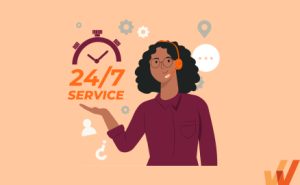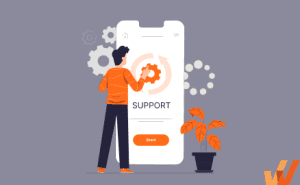15 Tips to Better Manage Your Support Ticket Queue
- Published: January 25, 2022
- Updated: January 11, 2024


The never-ending flow of support requests from customers can be nerve-wracking and overwhelming. Being able to organize and prioritize these requests helps increase customer satisfaction and prevents tickets from piling up.
Even the smallest of bottlenecks in your support ticket queue can negatively impact customer retention, making support queue management a necessary task.
Lots of customer support requests mean that the business is doing well. But ensuring it continues to do so– and that you don’t antagonize customers in the resolution process– means having a brilliant support team that you’ve trained in support ticket management.
6 Benefits of a Ticket Management System
- Helps organize the high volume of support tickets in a centralized system
- Consolidates all interactions in one thread
- Easily find the context of previous customer communications to offer personalized support
- Enables efficient team collaboration
- Focus on workload management due to automated processes
- Track customer service metrics and KPIs
Why Is a Support Ticket Management System Important?
Support queue management is a rough business. It can be overwhelming when your customer support team is buried in support tickets. Soaring response times are directly proportional to frustrated customers, low customer retention, and loss of money. A support ticket management system (known as a help desk) can help eliminate all that ails your customer support team and your customers.
An intelligent customer service ticket queue management strategy can help properly prioritize tickets and decrease response and resolution time. Such a system is vital to help businesses encumbered by high customer support requests.
It’s time organizations understood that exceptional customer support is mandatory in today’s competitive business environment. 82% of customers believe that the most significant factor for excellent customer service is the efficient resolution of their issues. Your biggest asset to offer the best customer support is a support ticket management system.
Here are a few more reasons why it is prudent to adopt a ticket management system for your business as soon as possible:
- It will help organize the high volume of support tickets in a centralized system.
- All interactions will be consolidated in one thread.
- You will find the context of previous customer communications to offer personalized support.
- It will enable efficient team collaboration.
- With many processes automated, you can focus on workload management.
- You can track customer service metrics and KPIs.
15 Ways to Effectively Manage Your Ticket Queue
Every business is different. What works for one might not work for the other. You may choose from the tips below to implement an efficient support ticket queue management system that works best for you. It should ideally help your team perform better and keep your tickets from stacking up.
1. Provide a Self-Service Support System
40% of customers would prefer to find answers to their queries themselves. Leverage the need for customers to feel empowered by offering self-service and knowledge-sharing options. Self-service tools can also help reduce operating costs and the burden on your customer support team.
Self-service also results in immediate solutions– especially if you’ve provided customers with access to a searchable knowledge base where you have listed frequently asked questions and offer user guides, manuals, wikis, etc. You may also automate your customer support using chatbots on your website or let customers get help from an AI-trained virtual agent which has the answers to most FAQs.

Above: Example of contextual help and user support built with a Digital Adoption Platform.
Whatfix’s Self-Help overlays on to any web application, desktop application, mobile app, or website. It provides contextual help to users and integrates with your FAQs, support center, LMS, user documentation, and more. Users are presented with common issues and help content for their contextual area in the application, or they can use an open-ended search to find the specific help content they’re looking for. These help support cards often prompt in-app guidance, walking users through the specific workflow they need help on.
2. Assign Priority on a First-Come Basis
A supply chain management method that works wonders for inventory is FIFO- “First In, First Out.” This can help maintain a balance between the incoming tickets and the resolved ones. It also ensures that no ticket exceeds the average resolution time.
Train your agents to answer tickets in the order they receive them. Even when you’re inundated with support requests and unsure where to start, the best place to start is with the oldest ticket.
3. Set and Monitor All Ticket Statuses
All tickets should be assigned a status. Use tags like “open,” “in-progress,” “pending,” and “resolved.” This helps your support ticket management software track the status of each ticket and highlight ones that have crossed the required resolution time.
Tagging tickets with the right status makes it easy to follow them and also keeps them from getting neglected or lost. You will also avoid duplication of efforts.
4. Use a Digital Adoption Platform for Better User Training and Support
A digital adoption platform (DAP) lets you train users in processes and data entry directly in the software interface. This support tool can be integrated with any company software, such as point of sale software, order management software, or support queue management software.
You will find that your staff becomes proficient in the use of your software faster with the real-time, personalized, and proactive support offered.
5. Give Biggest Clients Support Priority
You should aim to treat all customers equally, and your focus should always be to resolve all customer concerns as quickly as possible. However, prioritizing customers is one way to effectively organize your ticket queue. Valuable clients should be assigned to high payment tiers or a VIP category, and their requests should be fast-tracked.
For customers who are using your most expensive products or are your most loyal, undeterred buyers, flag their tickets as high-impact and give them top-notch service.
6. Automate Workflows Wherever Possible
Automation can help you fix the mind-numbing monotony of your work. Workflow automation can work wonders with your support queue management system. It can improve efficiency and deliver a proactive customer service experience by:
- Reducing human error
- Assigning tickets to the right subject matter expert
- Sending out notifications for idle and overdue tickets
- Prioritizing tickets as per customer importance

7. Invest in Better Support Software
We’re currently living through the era of omnichannel customer experience. You’re receiving support requests via your small business phone number, email, website, and even social media pages. Support ticket management software can help consolidate tickets from all channels and systems into one centralized interface.
Customer service tools enable a seamless agent experience by providing access to the customer information they need. This leads to improved internal collaboration, streamlined workflows, and happier customers.
Customer support software also stores data on the cloud to keep it secure and allow access to employees anywhere. One option you may consider is a hybrid cloud infrastructure. The hybrid cloud definition combines private and public clouds and eases workloads, reduces costs, and streamlines operations.
8. Create a Ticket-Tiering System
Categorizing customers ensures steady management of tickets. We have already discussed a tier system for high-value customers – but you could also consider a tier system that allows you to deal with the easiest tickets first. Resolving low-hanging fruit first helps to direct time and attention to tougher issues.
9. Continuously Train and Develop Your Support Staff
For every customer-centric organization, it is critical to empower your support teams with the right tools and resources. They can only help customers if they’re properly trained and have access to an extensive knowledge base. Enable your teams to work smarter and not harder.
10. Leave Detailed Ticket Description Notes
Agents can only tackle tickets if they have all the information provided. Ensure that detailed information is included in the notes at every customer support level. This helps avoid futile back and forth communications to find out basic information like customer address, order IDs, issue descriptions, etc. Explanatory notes make life easier for your agents.
11. Integrate Your Customer Relationship and Support Technologies
By integrating your helpdesk with your customer relationship management software (CRM), you’re aligning sales and support teams. It gives your customer support team information about the customer, their purchase history, and an overview of their customer journey.
Sometimes, customer support doesn’t have access to billing information that a customer might have a query about. Linking your CRM with your customer support software can help build a seamless customer profile for all departments to use.
12. Identify the Root Cause of Your Support Tickets
The best way to manage your support tickets is to reduce them by identifying the root cause. Find out what the most common help desk ticket types are and focus on resolving those problems at a strategic level. Collect data about recurring issues and suggest improvements to the product team.
13. Take Your Customer’s Geographic Location into Consideration
Knowing where your customers are generally located can help with prioritizing tickets. If they’re in your time zone, you could solve their issues first compared to someone who has probably left for the day and will check back on their query the next day. Geography can be one of the factors in your decision-making.
14. Assign a Triage Team
To avoid wasting time because of double handling errors, assign a team that can help prioritize tickets. Depending on the tier system you choose, they can tag tickets from high priority to low priority. A triage team can also scan through tickets to identify emergencies, spam, and duplicate conversations.
Allow your teams to become specialized, and let triage team teams assign tickets to the people who are the most competent at dealing with those specific issues.
15. Gather Customer Feedback on Your Support
Asking customers for feedback is imperative for continuous improvement in your support queue management. Customer insights can help you identify opportunities for improvement. Customer journey mapping tools can help identify the areas in the customer journey you need to focus on the most to provide a flawless customer experience – one that doesn’t allow for any customer support issues.

A customer help desk is a dynamic system that requires monitoring and regular adjustments. Change is inevitable, but what must not change is that customer satisfaction is your primary goal. Whichever of the above tips you choose to apply, ensure that you’re consistent and regularly monitor your core customer service metric for optimum performance.
Reduce your support tickets with on-demand, self-service customer support. Connect with us at Whatfix to find out more.
Request a demo to see how Whatfix empowers organizations to improve end-user adoption and provide on-demand customer support




